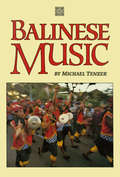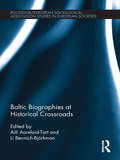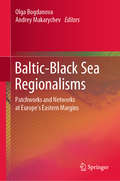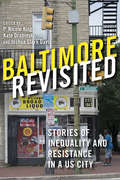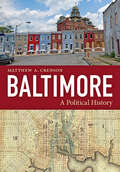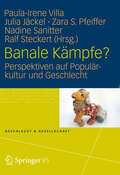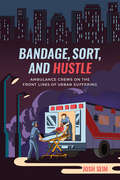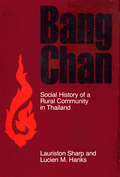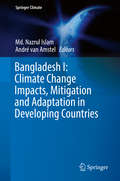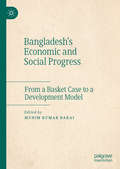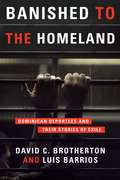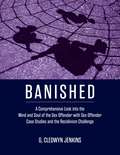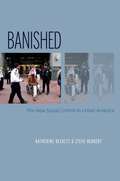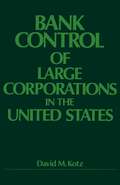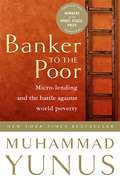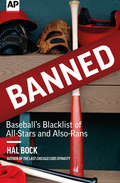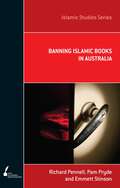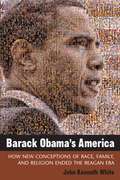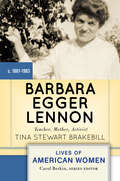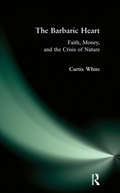- Table View
- List View
Balinese Music
by Michael TenzerThis authoritative book, newly revised and updated, presents an introduction to more than a dozen different types of Balinese gamelan, each with its own established tradition, repertoire and social or religious context. There are beautiful color photographs, a sonography, and a brief guide to studying and hearing music in Bali will prove indispensible to casual visitors and gamelan aficionados alike.
Ballad of the Bullet: Gangs, Drill Music, and the Power of Online Infamy
by Forrest StuartHow poor urban youth in Chicago use social media to profit from portrayals of gang violence, and the questions this raises about poverty, opportunities, and public voyeurismAmid increasing hardship and limited employment options, poor urban youth are developing creative online strategies to make ends meet. Using such social media platforms as YouTube, Twitter, and Instagram, they’re capitalizing on the public’s fascination with the ghetto and gang violence. But with what consequences? Ballad of the Bullet follows the Corner Boys, a group of thirty or so young men on Chicago’s South Side who have hitched their dreams of success to the creation of “drill music” (slang for “shooting music”). Drillers disseminate this competitive genre of hyperviolent, hyperlocal, DIY-style gangsta rap digitally, hoping to amass millions of clicks, views, and followers—and a ticket out of poverty. But in this perverse system of benefits, where online popularity can convert into offline rewards, the risks can be too great.Drawing on extensive fieldwork and countless interviews compiled from daily, close interactions with the Corner Boys, as well as time spent with their families, friends, music producers, and followers, Forrest Stuart looks at the lives and motivations of these young men. Stuart examines why drillers choose to embrace rather than distance themselves from negative stereotypes, using the web to assert their supposed superior criminality over rival gangs. While these virtual displays of ghetto authenticity—the saturation of social media with images of guns, drugs, and urban warfare—can lead to online notoriety and actual resources, including cash, housing, guns, sex, and, for a select few, upward mobility, drillers frequently end up behind bars, seriously injured, or dead.Raising questions about online celebrity, public voyeurism, and the commodification of the ghetto, Ballad of the Bullet offers a singular look at what happens when the digital economy and urban poverty collide.
Baltic Biographies at Historical Crossroads (Studies in European Sociology)
by Aili Aarelaid-Tart and Li Bennich-BjörkmanThis book brings together life stories from five generations of Balts, living through the diverse and recurring transformations of the twentieth century: occupations, war, independence, totalitarianism, and democratic rule and market economy. The twentieth century history of the Baltic countries has often been deeply tragic. Lying on the coastline of the Baltic Sea, these rather small but strategically well located territories have historically found themselves in the middle of many power struggles between larger states, empires and other power-holders: the Teutonic Knights, Swedish kings, Tsarist Russia, Nazi Germany, the Soviet Union. Today, they are once again forced to stand up to the Russian Federation. Biographical interviewing is a field focused on individuals, and on how those individuals choose to re-create and present their lived lives, make meaning of it through the narratives they tell. To interpret the biographical narrations of Lithuanians, Latvians and Estonians, shaped by complex and controversial historical background, the authors use Pierre Bourdieu’s concept of social and cultural capitals, the principles of Erving Goffman’s framing analysis and Alessandro Portelli’s distinction of private and public spheres, Anton Steen’s investigations of post-Socialist elites and Piotr Sztompka’s theory of cultural trauma, etc. Given analyses of particular biographical narrations are supplemented by brief historical and sociological overviews, which allow the reader to better understand the contexts of lived lives, and the mental atmosphere in which the interviews were conducted.
Baltic-Black Sea Regionalisms: Patchworks and Networks at Europe's Eastern Margins
by Andrey Makarychev Olga BogdanovaThis edited volume focuses on various forms of regionalism and neighborhoods in the Baltic-Black Sea area. In the light of current reshaping of borderlands and new geopolitical and military confrontations in Europe’s eastern margins, such as the annexation of Crimea and the war in Donbas, this book analyzes different types and modalities of regional integration and region-making from a comparative perspective. It conceptualizes cooperative and conflictual encounters as a series of networks and patchworks that differently link and relate major actors to each other and thus shape these interconnections as domains of inclusion and exclusion, bordering and debordering, securitization and desecuritization. This peculiar combination of geopolitics, ethnopolitics and biopolitics makes the Baltic-Black Sea trans-national region a source of inspiring policy practices, and, in the light of new security risks, a matter of increased concern all over Europe. The contributors from various disciplines cover topics such as cultural and civilizational spaces of belonging and identity politics, the rise of right-wing populism, region building under the condition of multiple security pressures, and the influence and regional strategies of different external powers, including the EU, Russia, and Turkey, on cross- and trans-regional relations in the area.
Baltimore Revisited: Stories of Inequality and Resistance in a U.S. City
by Nicole Fabricant Louise Parker Kelley Sam Collins Michelle L. Stefano Lawrence Brown Daniel L. Buccino Michael Casiano Shannon Darrow Matthew Durington Aiden Faust Jennifer A. Ferretti Leif Fredrickson Robert Gamble Marisela Gomez April K. Householder Jodi Kelber-Kaye Emily Lieb Jacob R. Levin Teresa Méndez Ashley Minner Elizabeth M. Nix Richard E. Otten Eli Pousson Mary Rizzo Fred Scharmen Aletheia Hyun-Jin Shin Linda Shopes Joe Tropea Amy Zanoni Denise Meringolo Robert Headley Shawntay StocksNicknamed both “Mobtown” and “Charm City” and located on the border of the North and South, Baltimore is a city of contradictions. From media depictions in The Wire to the real-life trial of police officers for the murder of Freddie Gray, Baltimore has become a quintessential example of a struggling American city. Yet the truth about Baltimore is far more complicated—and more fascinating. To help untangle these apparent paradoxes, the editors of Baltimore Revisited have assembled a collection of over thirty experts from inside and outside academia. Together, they reveal that Baltimore has been ground zero for a slew of neoliberal policies, a place where inequality has increased as corporate interests have eagerly privatized public goods and services to maximize profits. But they also uncover how community members resist and reveal a long tradition of Baltimoreans who have fought for social justice. The essays in this collection take readers on a tour through the city’s diverse neighborhoods, from the Lumbee Indian community in East Baltimore to the crusade for environmental justice in South Baltimore. Baltimore Revisited examines the city’s past, reflects upon the city’s present, and envisions the city’s future.
Baltimore: A Political History
by Matthew A. CrensonHow politics and race shaped Baltimore's distinctive disarray of cultures and subcultures.Charm City or Mobtown? People from Baltimore glory in its eccentric charm, small-town character, and North-cum-South culture. But for much of the nineteenth century, violence and disorder plagued the city. More recently, the 2015 death of Freddie Gray in police custody has prompted Baltimoreans—and the entire nation—to focus critically on the rich and tangled narrative of black–white relations in Baltimore, where slavery once existed alongside the largest community of free blacks in the United States.Matthew A. Crenson, a distinguished political scientist and Baltimore native, examines the role of politics and race throughout Baltimore's history. From its founding in 1729 up through the recent past, Crenson follows Baltimore's political evolution from an empty expanse of marsh and hills to a complicated city with distinct ways of doing business. Revealing how residents at large engage (and disengage) with one another across an expansive agenda of issues and conflicts, Crenson shows how politics helped form this complex city's personality.Crenson provocatively argues that Baltimore's many quirks are likely symptoms of urban underdevelopment. The city's longtime domination by the general assembly—and the corresponding weakness of its municipal authority—forced residents to adopt the private and extra-governmental institutions that shaped early Baltimore. On the one hand, Baltimore was resolutely parochial, split by curious political quarrels over issues as minor as loose pigs. On the other, it was keenly attuned to national politics: during the Revolution, for instance, Baltimoreans were known for their comparative radicalism. Crenson describes how, as Baltimore and the nation grew, whites competed with blacks, slave and free, for menial and low-skill work. He also explores how the urban elite thrived by avoiding, wherever possible, questions of slavery versus freedom—just as wealthier Baltimoreans, long after the Civil War and emancipation, preferred to sidestep racial controversy. Peering into the city's 300-odd neighborhoods, this fascinating account holds up a mirror to Baltimore, asking whites in particular to reexamine the past and accept due responsibility for future racial progress.
Banal Nationalism
by Michael BilligMichael Billig presents a major challenge to orthodox conceptions of nationalism in this elegantly written book. While traditional theorizing has tended to the focus on extreme expressions of nationalism, the author turns his attention to the everyday, less visible forms which are neither exotic or remote, he describes as `banal nationalism′. The author asks why people do not forget their national identity. He suggests that in daily life nationalism is constantly flagged in the media through routine symbols and habits of language. Banal Nationalism is critical of orthodox theories in sociology, politics and social psychology for ignoring this core feature of national identity. Michael Billig argues forcefully that with nationalism continuing to be a major ideological force in the contemporary world, it is all the more important to recognize those signs of nationalism which are so familiar that they are easily overlooked.
Banale Kämpfe?: Perspektiven auf Populärkultur und Geschlecht (Geschlecht und Gesellschaft #51)
by Zara Pfeiffer Ralf Steckert Julia Jäckel Paula-Irene Villa Nadine SanitterWie inszeniert Lady Gaga Weiblichkeit über ihre Haarpracht? Warum schreiben Frauen* ,schwulen Porn'? Ist Jack Bauer ein tragischer Held? Können Geschlechterverhältnisse in der Populärkultur kritisch unterlaufen werden? Auseinandersetzungen mit Popula rkulturen sind von kontroversen Sichtweisen gepra gt, die vor allem in der Frage nach affirmativen und subversiven Momenten sichtbar werden. Interdependente Geschlechterverhältnisse spielen in diesen Diskussionen eine zentrale Rolle. Der Sammelband präsentiert Beitra ge aus den Sozial- und Geisteswissenschaften, die diese Auseinandersetzung führen.
Bandage, Sort, and Hustle: Ambulance Crews on the Front Lines of Urban Suffering
by Josh SeimWhat is the role of the ambulance in the American city? The prevailing narrative provides a rather simple answer: saving and transporting the critically ill and injured. This is not an incorrect description, but it is incomplete. Drawing on field observations, medical records, and his own experience as a novice emergency medical technician, sociologist Josh Seim reimagines paramedicine as a frontline institution for governing urban suffering. Bandage, Sort, and Hustle argues that the ambulance is part of a fragmented regime that is focused more on neutralizing hardships (which are disproportionately carried by poor people and people of color) than on eradicating the root causes of agony. Whether by compressing lifeless chests on the streets or by transporting the publicly intoxicated into the hospital, ambulance crews tend to handle suffering bodies near the bottom of the polarized metropolis. Seim illustrates how this work puts crews in recurrent, and sometimes tense, contact with the emergency department nurses and police officers who share their clientele. These street-level relations, however, cannot be understood without considering the bureaucratic and capitalistic forces that control and coordinate ambulance labor from above. Beyond the ambulance, this book motivates a labor-centric model for understanding the frontline governance of down-and-out populations.
Banding Together: How Communities Create Genres in Popular Music
by Jennifer C. LenaWhy do some music styles gain mass popularity while others thrive in small niches? Banding Together explores this question and reveals the attributes that together explain the growth of twentieth-century American popular music. Drawing on a vast array of examples from sixty musical styles--ranging from rap and bluegrass to death metal and South Texas polka, and including several created outside the United States--Jennifer Lena uncovers the shared grammar that allows us to understand the cultural language and evolution of popular music. What are the common economic, organizational, ideological, and aesthetic traits among contemporary genres? Do genres follow patterns in their development? Lena discovers four dominant forms--Avant-garde, Scene-based, Industry-based, and Traditionalist--and two dominant trajectories that describe how American pop music genres develop. Outside the United States there exists a fifth form: the Government-purposed genre, which she examines in the music of China, Serbia, Nigeria, and Chile. Offering a rare analysis of how music communities operate, she looks at the shared obstacles and opportunities creative people face and reveals the ways in which people collaborate around ideas, artworks, individuals, and organizations that support their work.
Bandits and Bureaucrats The Ottoman Route the State Centralization
by Karen BarkeyDiscusses the process of state-building in the Ottoman Empire.
Bang Chan: Social History of a Rural Community in Thailand (Cornell Studies in Anthropology)
by Lauriston Sharp Lucien M. HanksBang Chan traces the changing cultural characteristics of a small Siamese village during the century and a quarter from its founding as a wilderness settlement outside Bangkok to its absorption into the urban spread of the Thai capital. Rich in ethnographic detail, the book sums up the major findings of a pioneering interdisciplinary research project that began in 1948. Changes in Bang Chan's social organization, technology, economy, governance, education, and religion are portrayed in the context of local and national developments.
Bangladesh I: Climate Change Impacts, Mitigation, and Adaptation in Developing Countries (Springer Climate)
by Md. Nazrul Islam André Van AmstelThe aim of this book is to provide information to scientists and local government to help them better understand the particularities of the local climate. Climate change is one of the biggest challenges to society. It can lead to serious impacts on production, life and environment on a global scale. Higher temperatures and sea level rise will cause flooding and water salinity problems which bring about negative effects on agriculture and high risks to industry and socio-economic systems in the future. Climate change leads to many changes in global development and security, especially energy, water, food, society, job, diplomacy, culture, economy and trade. The Intergovernmental Panel on Climate Change (IPCC) defines climate change as: “Any change in climate over time, whether due to natural variability or as a result of human activity.” Global climate change has emerged as a key issue in both political and economic arenas. It is an increasingly questioned phenomenon, and progressive national governments around the world have started taking action to respond to these environmental concerns.
Bangladesh's Economic and Social Progress: From a Basket Case to a Development Model
by Munim Kumar BaraiThis book evaluates Bangladesh’s impressive economic and social progress, more often referred to as a ‘development surprise’. In doing so, the book examines the gap in existing explanations of Bangladesh’s development and then offers an empirically informed analysis of a range of distinctive factors, policies, and actions that have individually and collectively contributed to the progress of Bangladesh. In an inclusive way, the book covers the developmental role, relation, and impact of poverty reduction, access to finance, progress in education and social empowerment, reduction in the climatic vulnerability, and evolving sectoral growth activities in the agriculture, garments, and light industries. It also takes into account the important role of the government and NGOs in the development process, identifies bottlenecks and challenges to Bangladesh’s future development path and suggests measures to overcome them.By providing an inclusive narrative to theorize Bangladesh’s development, which is still missing in the public discourse, this book posits that Bangladesh per se can offer a development model to other developing countries.
Banished to the Homeland: Dominican Deportees and Their Stories of Exile
by David C. Brotherton Luis BarriosThe 1996 U.S. Immigration Reform and Responsibility Act has led to the forcible deportation of tens of thousands of Dominicans from the United States. Following thousands of these individuals over a seven-year period, David C. Brotherton and Luis Barrios use a unique combination of sociological and criminological reasoning to isolate the forces that motivate emigrants to leave their homeland and then commit crimes in the Unites States violating the very terms of their stay. Housed in urban landscapes rife with gangs, drugs, and tenuous working conditions, these individuals, the authors find, repeatedly play out a tragic scenario, influenced by long-standing historical injustices, punitive politics, and increasingly conservative attitudes undermining basic human rights and freedoms. Brotherton and Barrios conclude that a simultaneous process of cultural inclusion and socioeconomic exclusion best explains the trajectory of emigration, settlement, and rejection, and they mark in the behavior of deportees the contradictory effects of dependency and colonialism: the seductive draw of capitalism typified by the American dream versus the material needs of immigrant life; the interests of an elite security state versus the desires of immigrant workers and families to succeed; and the ambitions of the Latino community versus the political realities of those designing crime and immigration laws, which disadvantage poor and vulnerable populations. Filled with riveting life stories and uncommon ethnographic research, this volume relates the modern deportee's journey to broader theoretical studies in transnationalism, assimilation, and social control.
Banished: A Comprehensive Look into the Mind and Soul of the Sex Offender with Sex Offender Case Studies and the Recidivism Challenge
by Greg Cledwyn Jenkins, PhD, D.MinBanished presents a detailed review of the sex offender; the pedophile and the child molester, and directly explores his thinking processes, reasoning and related issues that offer a clear and concise exposé in these most hated people. In addition
Banished: The New Social Control In Urban America
by Steve Herbert Katherine BeckettWith urban poverty rising and affordable housing disappearing, the homeless and other "disorderly" people continue to occupy public space in many American cities. Concerned about the alleged ill effects their presence inflicts on property values and public safety, many cities havewholeheartedly embraced "zero-tolerance" or "broken window" policing efforts to clear the streets of unwanted people. Through an almost completely unnoticed set of practices, these people are banned from occupying certain spaces. Once zoned out, they are subject to arrest if they return -effectively banished from public places. Banished is the first exploration of these new tactics that dramatically enhance the power of the police to monitor and arrest thousands of city dwellers. Drawing upon an extensive body of data, the authors chart the rise of banishment in Seattle, a city on the leading edge of this emerging trend,to establish how it works and explore its ramifications. They demonstrate that, although the practice allows police and public officials to appear responsive to concerns about urban disorder, it is a highly questionable policy: it is expensive, does not reduce crime, and does not address theunderlying conditions that generate urban poverty. Moreover, interviews with the banished themselves reveal that exclusion makes their lives and their path to self-sufficiency immeasurably more difficult. At a time when more and more cities and governments in the U. S. and Europe resort to the criminal justice system to solve complex social problems, Banished provides a vital and timely challenge to exclusionary strategies that diminish the life circumstances and rights of those it targets.
Bank Control of Large Corporations in the United States
by David M. Kotz"Truly a distinguished piece of work, based on new data that had not been analyzed before. There is an excellent combination of historical perspective, conscientious examination of a great mass of data, and penetrating analysis." --Robert Aaron Gordon, Charter Member of the Brookings Panel on Economic Activity "Contends that since the Second World War, a small number of 'giant, well-established' banks in a few major cities have re-emerged as the major group that controls large corporations. Places the financial control thesis in historical perspective from the Civil War to the present and then examines the control of the two hundred largest U.S. corporations in 1967-69 in terms of owner control, financial control, and no identified center of control. Also comments on the means of exercising control. ... the author finds that a substantial portion of the largest nonfinancial corporations in 1967-69 were under the control of financial institutions; the control is exercised through the ownership of stock and the role of the bankers as creditors of the corporations."--Journal of Economic Literature "Recent empirical evidence, made available through congressional hearings, reveals that large banking groups are exercising substantial influence over nonfinancial corporations. This is accomplished through stockholdings, creditor relationships, and directorship ties. In this excellent historical statistical analysis, Katz assesses the extent and impact of such control in a competitive economy." --Library Journal
Banker to the Poor: Micro-lending and the Battle Against World Poverty
by Alan Jolis Muhammad YunusWinner of the Nobel Peace Prize describes how he founded Grameen Bank that is devoted to providing poor people with miniscule loans. The bank has provided 3.8 billion dollars to 2.4 million families in rural Bangladesh, enabling them to lift themselves out of poverty forever.
Banned: Baseball's Blacklist of All-Stars and Also-Rans
by Hal Bock The Associated PressAward-winning Associated Press sports writer Hal Bock brings us a fascinating history of the players, coaches and more barred from baseball's ranks, from Shoeless Joe Jackson to Jenrry Mejia. "Banned: Baseball's Blacklist of All-Stars and Also-Rans" weaves together tales of lesser-known characters from baseball's early years with infamous outlaws who have endured throughout the decades. Featuring stories of players like Eddie "The Only" Nolan, Cozy Dolan, Leo Durocher, and Pete Rose who have been expelled or suspended from the sport, Bock's chronicle delves deep into baseball's colorful history. For those who follow the current corporate era of businessmen players and billionaire owners, this book serves as a reminder that America's Pastime evolved from the days when gamblers filled the stands and influenced poorly paid scoundrels on the diamond.In his over 40-year career, Hal Bock has covered every major event on the sports calendar, including 30 World Series, 30 Super Bowls and 11 Olympic Games, making him the perfect storyteller for this retrospective. Featuring an introduction by John Thorn, the Official Historian of Major League Baseball, and more than 25 photographs from the Associated Press archives, "Banned" is a must-read for any fan of the game.
Banning Islamic Books in Australia (Islamic Studies Series)
by Emmett Stinson Richard Pennell Pam PrydeIn 2005, the Australian Federal Police referred eight Islamic books to the Australian Classification Board. The goal was to secure a ban of the books, all of which were alleged to advocate 'terrorist acts'. After nearly a year of review, and intense public debate, two of the books were refused classification and effectively banned in a move that would have severe repercussions for librarians, scholars, authors and the state of free speech in Australia.Banning Islamic Books in Australia examines the cultural and political contexts that led up to the ban, and the content of the books themselves in an attempt to determine what it was that made them seem so dangerous. It also documents the unintended consequences of the ban on library collections and academic freedom, and how this in turn affects free speech in contemporary Australia. Islamic Studies Series - Volume 9
Barack Obama's America: How New Conceptions of Race, Family, and Religion Ended the Reagan Era
by John Kenneth White"White'sBarack Obama's Americaeloquently captures both the important nuances of the current political scene and its long-term consequences. " ---Richard Wirthlin, former pollster for Ronald Reagan "This delightfully written and accessible book is the best available account of the changes in culture, society, and politics that have given usBarack Obama's America. " ---Stan Greenberg, pollster for Bill Clinton and Chairman and CEO of Greenberg Quinlan Rosner Research "From one of the nation's foremost experts on how values shape our politics, a clear and compelling account of the dramatic shifts in social attitudes that are transforming American political culture. White's masterful blend of narrative and data illuminates the arc of electoral history from Reagan to Obama, making a powerful case for why we are entering a new progressive political era. " ---Matthew R. Kerbel, Professor of Political Science, Villanova University, and author ofNetroots "John Kenneth White is bold. He asks the big questions . . . Who are we? What do we claim to believe? How do we actually live? What are our politics? John Kenneth White writes compellingly about religion and the role it played in making Barack Obama president. White's keen insight into America's many faiths clarifies why Barack Obama succeeded against all odds. It is a fascinating description of religion and politics in twenty-first-century America---a must-read. " ---Kathleen Kennedy Townsend, former Lieutenant Governor of Maryland and author ofFailing America's Faithful "InBarack Obama's America,John Kenneth White has written the political equivalent of Baedeker or Michelin, the definitive guide to and through the new, uncharted political landscape of our world. White captures and explains what America means---and what it means to be an American---in the twenty-first century. " ---Mark Shields, nationally syndicated columnist and political commentator for PBS NewsHour "John White has always caught important trends in American politics that others missed. With his shrewd analysis of why Barack Obama won, he's done it again. " ---E. J. Dionne, Jr. , Senior Fellow, Brookings Institution, and University Professor in the Foundations of Democracy and Culture at Georgetown University The election of Barack Obama to the presidency marks a conclusive end to the Reagan era, writes John Kenneth White inBarack Obama's America. Reagan symbolized a 1950s and 1960s America, largely white and suburban, with married couples and kids at home, who attended church more often than not. Obama's election marks a new era, the author writes. Whites will be a minority by 2042. Marriage is at an all-time low. Cohabitation has increased from a half-million couples in 1960 to more than 5 million in 2000 to even more this year. Gay marriages and civil unions are redefining what it means to be a family. And organized religions are suffering, even as Americans continue to think of themselves as a religious people. Obama's inauguration was a defining moment in the political destiny of this country, based largely on demographic shifts, as described inBarack Obama's America. John Kenneth White is Professor of Politics at the Catholic University of America in Washington, D. C. Cover image: "Out of many, we are one: Dare to Hope: Faces from 2008 Obama Rallies" by Anne C. Savage, view and buy full image at http://revolutionaryviews. com/obama_poster. html.
Barbara Egger Lennon: Teacher, Mother, Activist
by Tina Stewart BrakebillFacets of Barbara Egger Lennon’s life define her as an ordinary white Midwestern woman of her time: teacher, wife, mother. Her work as a union organizer and political activist, however, complicate that picture. The way in which she balanced these roles illustrates how many women of her time shaped their lives in the face of three significant forces: work, family, and politics. Enriched by years of detailed diary entries that Egger Lennon wrote, Barbara Egger Lennon: Teacher, Mother, Activist deepens our understanding of the ways in which work and political activism could exist alongside the traditional role of women in the early 20th century. About the Lives of American Women series: Selected and edited by renowned women’s historian Carol Berkin, these brief biographies are designed for use in undergraduate courses. Rather than a comprehensive approach, each biography focuses instead on a particular aspect of a women’s life that is emblematic of her time, or which made her a pivotal figure in the era. The emphasis is on a "good read,” featuring accessible writing and compelling narratives, without sacrificing sound scholarship and academic integrity. Primary sources at the end of each biography reveal the subject’s perspective in her own words. Study questions and an annotated bibliography support the student reader.
Barbara Egger Lennon: Teacher, Mother, Activist
by Tina Stewart BrakebillFacets of Barbara Egger Lennon’s life define her as an ordinary white Midwestern woman of her time: teacher, wife, mother. Her work as a union organizer and political activist, however, complicate that picture. The way in which she balanced these roles illustrates how many women of her time shaped their lives in the face of three significant forces: work, family, and politics. Enriched by years of detailed diary entries that Egger Lennon wrote, Barbara Egger Lennon: Teacher, Mother, Activist deepens our understanding of the ways in which work and political activism could exist alongside the traditional role of women in the early 20th century. About the Lives of American Women series: Selected and edited by renowned women’s historian Carol Berkin, these brief biographies are designed for use in undergraduate courses. Rather than a comprehensive approach, each biography focuses instead on a particular aspect of a women’s life that is emblematic of her time, or which made her a pivotal figure in the era. The emphasis is on a "good read,” featuring accessible writing and compelling narratives, without sacrificing sound scholarship and academic integrity. Primary sources at the end of each biography reveal the subject’s perspective in her own words. Study questions and an annotated bibliography support the student reader.
Barbaric Heart: Faith, Money, and the Crisis of Nature
by Curtis WhiteSmart, funny, and fresh, The Barbaric Heart argues that the present environmental crisis will not be resolved by the same forms of crony capitalism and managerial technocracy that created the crisis in the first place. With his trademark wit, White argues that the solution might very well come from an unexpected quarter: the arts, religion, and the realm of the moral imagination.
